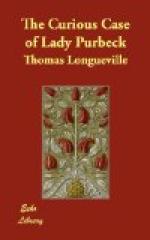If ever there was a case of adding insult to injury, surely this piece of canting impertinence was one of the most outrageous.
FOOTNOTES:
[3] Life of Sir Edward Coke. By H.W. Woolrych. London: J. & W.T. Clarke, 1826, pp. 145-48.
[4] Lipscomb’s History and Antiquities of the Co. of Bucks, 1847, Vol. IV., p. 548.
[5] Gray made the churchyard of Stoke Pogis the scene of his famous Elegy, and he was buried there in 1771.
[6] Ency. Brit., Vol. XIV. Article on London.
[7] Lady Elizabeth’s house in Holborn was called Hatton House. A letter (S.P. Dom., James I., 13th July, 1622) says: “Lady Hatton sells her house in Holborn to the Duke of Lennox, for L12,000.” Another letter (ib. 26th February, 1628) says that “Lady Hatton complained so much of her bargain with the Duchess of Richmond for Hatton House, that the Duchess has taken her at her word and left it on her hands, whereby she loses L1,500 a year, and L6,000 fine.”
[8] “Under no man’s judgment should the King lie; but under God and the law only.”
[9] Letter from John Castle. See D’Israeli’s Character of James I., p. 125.
[10] Cabala Sive Scrina Sacra: Mysteries of State and Government. In Letters of Illustrious Persons, etc. London: Thomas Sawbridge and others, 1791, p. 86.
CHAPTER III.
“Marriage
is a matter of more worth
Than
to be dealt in by attorneyship.”
Henry
VI., I., v., 5.




